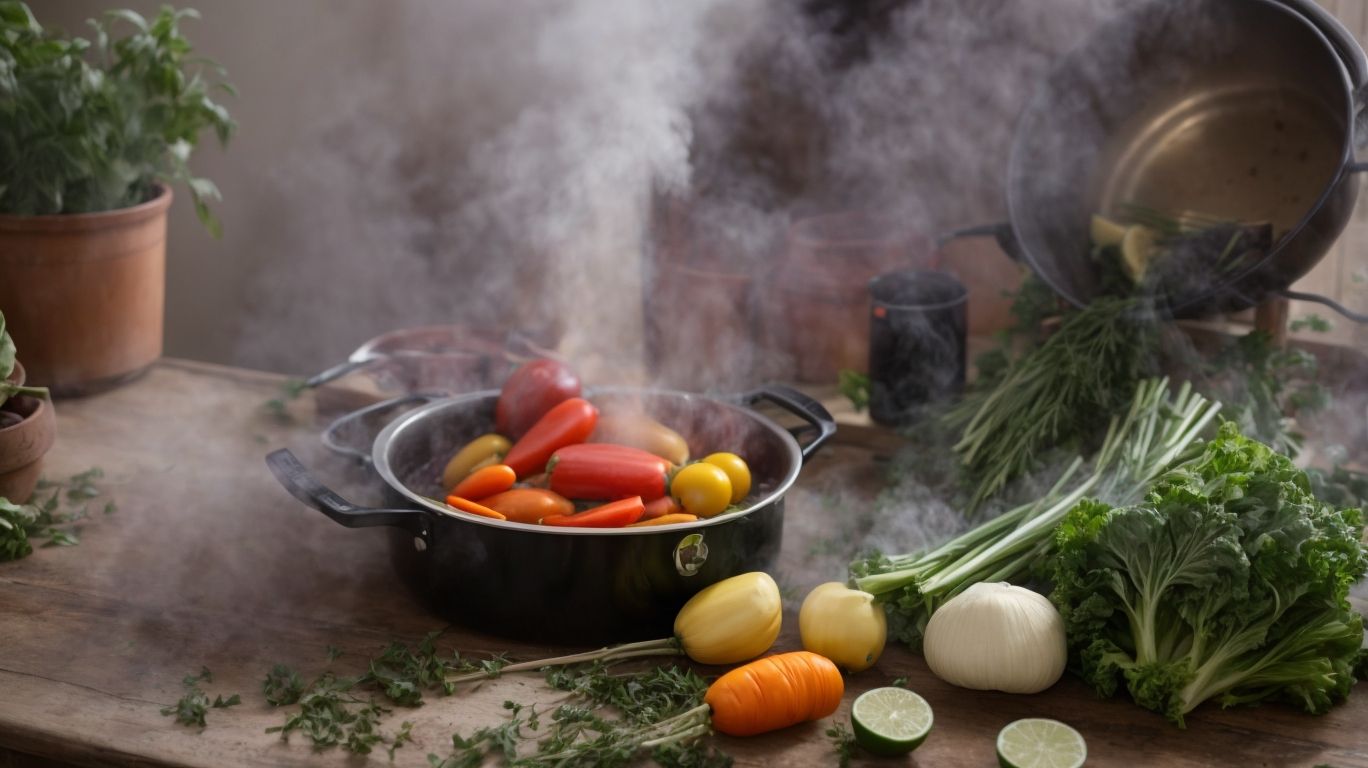How to Cook Vegetables by Steam?
Are you looking for a simple and healthy way to cook vegetables that retains their nutrients and enhances their flavors? Look no further than steaming!
We will explore why steaming vegetables is a great cooking method, what vegetables can be steamed, how to prepare them for steaming, different methods of steaming, tips for perfectly steamed vegetables, and creative ways to serve them.
Come with me as we delve into the world of steaming vegetables and get ready to experiment and enjoy delicious and nutritious dishes!
Key Takeaways:
Why Choose to Cook Vegetables by Steam?
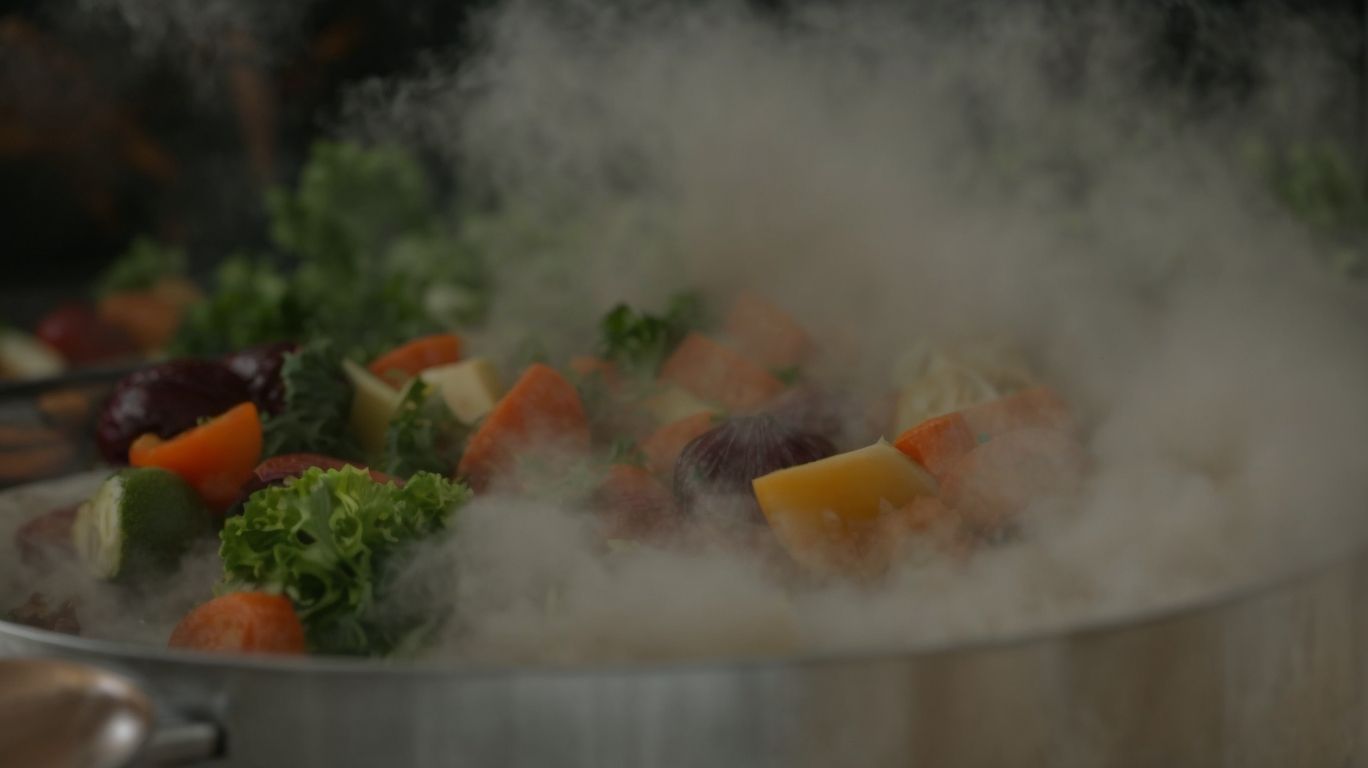
Credits: Poormet.Com – Dennis Mitchell
Cooking vegetables by steam offers numerous benefits that appeal to health-conscious individuals and culinary enthusiasts alike. The method of steaming vegetables helps retain their natural nutrients, ensuring a healthier dish compared to other cooking techniques.
Steaming vegetables enhances their natural flavors, making them taste more vibrant and fresh. Another advantage of steaming is that it requires minimal equipment, simply a pot with a steamer basket or a microwave-safe dish with a cover. This simplicity not only saves countertop space but also makes the cooking process a breeze.
Steaming vegetables is a time-saving cooking method as it typically takes less time than other techniques like boiling or frying. This quick and efficient process allows you to prepare a nutritious meal in a flash, perfect for busy weekdays or when you’re looking for a hassle-free cooking method.
Retains Nutrients
Steaming vegetables is a cooking method that helps retain essential nutrients, such as vitamins and minerals, present in vegetables like broccoli, cauliflower, green beans, and carrots.
When you steam these veggies, you are preserving their nutritional value as compared to other cooking methods that can lead to nutrient loss. Broccoli, for instance, is a powerhouse of Vitamin C and K, along with antioxidants, which are retained well through steaming.
Cauliflower, on the other hand, is rich in fiber, and steaming helps maintain its nutrient content, including Vitamin C, Vitamin K, and other essential minerals.
Green beans and carrots, both high in antioxidants and beta carotene, benefit greatly from steaming, ensuring that these valuable components are not lost during the cooking process. Steaming also helps in retaining their vibrant colors, making them not only nutritious but visually appealing on your plate.
Enhances Flavor
Steaming vegetables not only preserves nutrients but also enhances their natural flavors when paired with ingredients like olive oil, kosher salt, and fresh herbs.
When you steam vegetables, the gentle cooking method allows them to retain more of their inherent taste profiles, ensuring a burst of flavor with every bite. The addition of olive oil not only imparts a rich and silky texture but also helps to carry the flavors of the vegetables more effectively. Meanwhile, the use of kosher salt enhances the overall taste by adding a perfect balance of seasoning that complements the veggies. Incorporating fresh herbs can elevate the dish to new heights, infusing it with aromatic notes and a touch of freshness.
Requires Minimal Equipment
One of the key advantages of steaming vegetables is that it requires minimal equipment, typically just a steamer basket and a pot, making it an accessible cooking method for all.
Steaming preserves the nutrients and natural flavors of vegetables better than other cooking methods, ensuring a healthy and delicious dish every time.
- With a steamer basket, you can easily stack different vegetables and cook them simultaneously, saving time and energy.
- The process is simple: just fill the pot with a small amount of water, place the basket with the veggies inside, cover it with a lid, and let the steam work its magic.
Unlike boiling, steaming doesn’t require submerging vegetables in water, which can lead to nutrient loss. It’s a gentle and efficient way to cook, suitable for a wide range of vegetables, from broccoli and carrots to cauliflower and green beans.
Saves Time
Steaming vegetables is a time-efficient cooking method as it requires minimal preparation and precise timing to achieve the desired level of doneness without excessive use of water.
When you steam vegetables, the steam created acts as a gentle, indirect heat source that helps retain the vegetables’ nutrients while keeping them tender and flavorful. The beauty of steaming lies in its ability to cook vegetables quickly and evenly, without the need for constant monitoring. By managing the amount of water used in the steaming process, you can ensure that the vegetables are not waterlogged or overcooked, resulting in a perfectly balanced texture and taste.
What Vegetables Can Be Cooked by Steam?
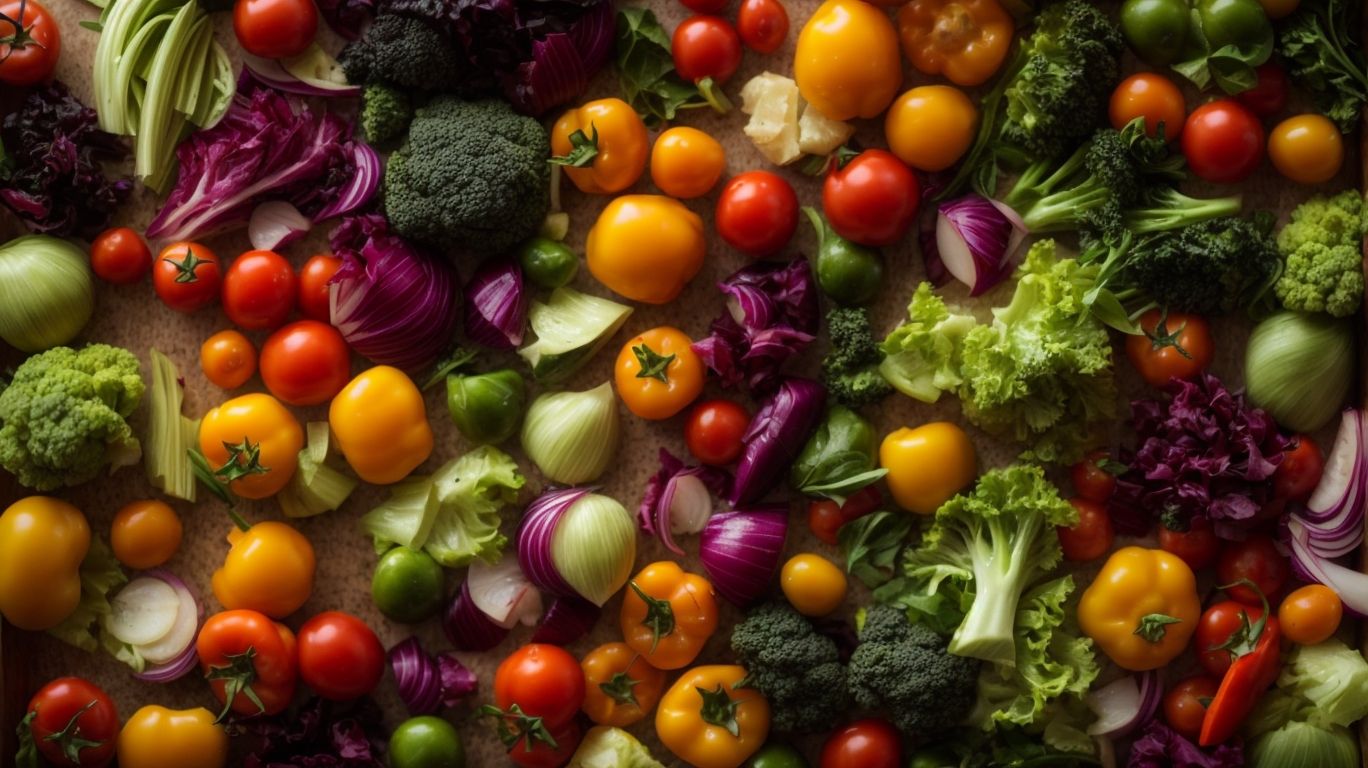
Credits: Poormet.Com – Ethan Torres
A wide variety of vegetables can be cooked to perfection by steam, including popular choices such as broccoli, cauliflower, green beans, and carrots, each offering unique flavors and textures when steamed.
Broccoli, known for its vibrant green color and distinctive flavor, becomes tender yet retains a slight crunchiness when steamed, making it a versatile and nutritious option for any meal.
Cauliflower, when steamed, softens slightly while still maintaining a pleasant bite, delivering a mild, nutty taste that pairs well with a variety of seasonings.
Green beans, also known as string beans, maintain their vibrant color and crisp texture when steamed, offering a delightful crunch and a fresh, natural sweetness.
Carrots, with their bright orange hue and sweet, earthy flavor, soften to perfection when steamed, making them a nutritious and delicious side dish or snack.
Leafy Greens (Kale, Spinach, etc.)
Leafy greens such as kale and spinach are excellent choices for steaming, as this cooking method helps preserve their vibrant colors and nutrient profiles.
Steaming these leafy greens retains their crisp texture and prevents them from becoming mushy, which can happen with other cooking methods like boiling. The gentle heat of steaming also ensures that the vegetables maintain their natural flavors, making them a delicious and healthy addition to any meal.
Plus enhancing the taste and texture of kale and spinach, steaming also locks in essential vitamins and minerals, such as vitamin C, vitamin K, and folate. These leafy greens are already packed with antioxidants, fiber, and other nutrients that promote overall health, and steaming them helps preserve these beneficial compounds.
Root Vegetables (Carrots, Potatoes, etc.)
Root vegetables, including carrots and potatoes, can be transformed into tender delights through the gentle steaming process, preserving their natural sweetness and textures.
Steaming these root vegetables not only accentuates their inherent flavors but also helps retain their nutrients better compared to other cooking methods that might lead to nutrient loss. When steamed, carrots and potatoes maintain a pleasant bite while becoming effortlessly fork-tender, making them versatile ingredients in dishes ranging from soups to stews. The steaming process locks in the vibrant colors of these vegetables, enhancing the visual appeal of your culinary creations. Whether enjoyed as a standalone side dish or incorporated into elaborate recipes, steamed root vegetables are a culinary delight worth savoring.
Cruciferous Vegetables (Broccoli, Cauliflower, etc.)
Cruciferous vegetables like broccoli and cauliflower shine when steamed, offering a delicate yet flavorful outcome that captures the essence of these nutritious vegetables.
Steaming these vegetables helps to preserve their vibrant colors, retain their nutrients, and enhance their natural flavors. Not only does steaming broccoli and cauliflower maintain their firm texture, but it also ensures that they remain tender without becoming mushy. This cooking method is quick and easy, making it perfect for busy weeknights when you want a healthy side dish in a flash.
- Steamed cruciferous vegetables are rich in essential vitamins like Vitamin C and K, as well as minerals such as potassium and calcium.
- The gentle cooking process of steaming helps to break down the fibers in the vegetables, making them easier to digest and absorb nutrients.
Other Vegetables (Asparagus, Green Beans, etc.)
Besides the classics, other vegetables like asparagus and green beans take on a delightful character when steamed, especially when seasoned with olive oil and kosher salt.
Asparagus, known for its tender spears and earthy undertones, retains its vibrant green hue and subtle crunchiness when steamed, offering a fresh, almost grassy flavor profile.
On the other hand, green beans, with their crisp texture and slightly sweet taste, become even more pronounced through the gentle steaming process, ensuring a perfect balance of flavors.
When seasoned with olive oil and kosher salt, these vegetables absorb the rich, fruity notes of the oil while the salt enhances their natural flavors without overpowering them. This simple yet effective seasoning combination elevates the overall taste, amplifying the intrinsic goodness of the vegetables.
How to Prepare Vegetables for Steaming?
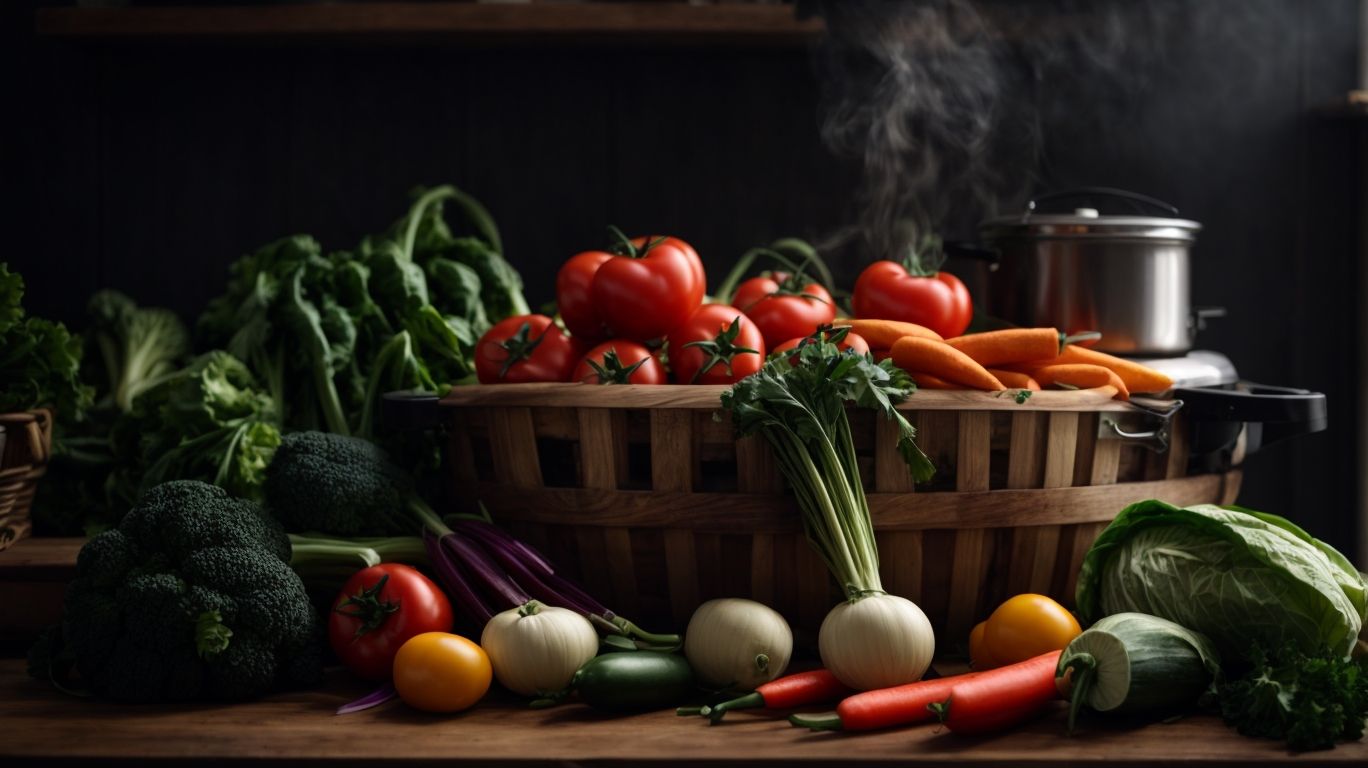
Credits: Poormet.Com – Randy Jackson
Preparing vegetables for steaming involves essential steps such as washing, cutting, and optional seasoning to enhance the flavors before the steaming process begins.
Before diving into the preparation process, ensure to pick fresh vegetables, free from any blemishes. Start by rinsing them under cold water, using a colander to remove any dirt or debris. For cutting, consider uniform sizes to ensure even cooking; you can opt for slices, cubes, or julienne cuts depending on the dish. Seasoning your vegetables can significantly elevate the taste – try olive oil, garlic, herbs, or a sprinkle of salt and pepper. Experiment to find your favorite combination!
Wash and Cut
The initial steps of washing and cutting vegetables are crucial for the steaming process, ensuring cleanliness and proper sizing for even cooking.
Washing removes any dirt, pesticides, or residues present on the skin of vegetables, thus promoting a healthier dish. Uniform cutting helps in uniform cooking, avoiding some pieces being overdone while others remain undercooked. Consistent sizing also ensures that items finish cooking at the same time, providing a balanced flavor profile. Uniform pieces enhance the visual appeal of the dish, making it more appetizing.
By taking these steps, you set the foundation for a successful and delicious steamed vegetable dish. Remember, the little details in preparation can make a significant difference in the final outcome!
Season and Marinate (Optional)
Seasoning and marinating vegetables before steaming can elevate the final dish, with options like olive oil, kosher salt, and a variety of fresh herbs enhancing the flavors.
When you season your veggies before steaming, it allows the ingredients to infuse and add depth to the overall taste profile. The olive oil helps in enhancing the richness, while the kosher salt works to bring out the natural flavors of the vegetables. The fresh herbs not only provide a burst of freshness but also bring a beautiful aroma to the dish.
By marinating the vegetables with these seasonings, you are not only imparting flavor but also tenderizing the veggies, making them more succulent and enjoyable. The marinade acts as a flavor carrier, resulting in vegetables that are not only healthier but also more delightful to the taste buds.
Methods of Steaming Vegetables
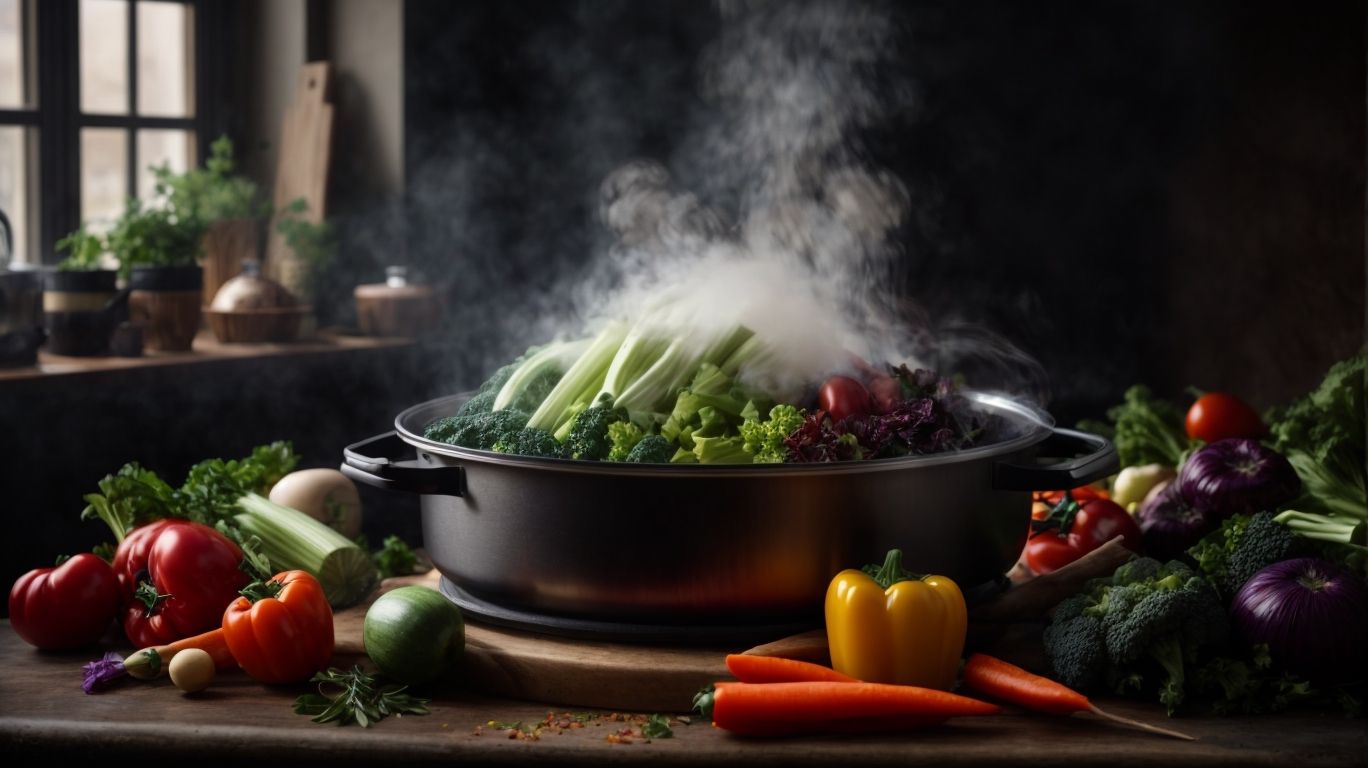
Credits: Poormet.Com – Michael Lopez
Steaming vegetables can be achieved through various methods, including stovetop steaming, microwave steaming, and the use of electric steamers, each offering unique advantages based on convenience and speed.
Stovetop steaming is a traditional and versatile method that requires a pot with a steamer basket. Simply fill the pot with a small amount of water, bring it to a boil, add the vegetables to the steamer basket, cover, and let them cook until tender.
On the other hand, microwave steaming is quick and efficient, perfect for those short on time. You can place the vegetables in a microwave-safe container with a bit of water, cover it, and microwave until cooked.
Stovetop Steaming
Stovetop steaming is a traditional and effective method for cooking vegetables, requiring a pot, water, and precise heat control to achieve perfectly steamed results.
Choosing the right pot for steaming is crucial to ensure even heat distribution. Opt for a pot with a tight-fitting lid to trap the steam inside during the cooking process. When adding water, it should be just enough to create steam but not touch the vegetables. Water management is essential here to prevent the vegetables from getting waterlogged. Adjust the heat to maintain a gentle but steady simmer; too high heat can lead to overcooking or scorching. Always keep an eye on the water level to avoid it boiling dry and potentially damaging the pot.
Microwave Steaming
Microwave steaming provides a quick and convenient way to cook vegetables, with precise timing and method adjustments crucial for achieving the desired level of doneness.
One key factor in microwave steaming is the size and type of vegetables being cooked. Denser vegetables like potatoes may require longer cooking times compared to softer ones like broccoli. To ensure even cooking, it’s recommended to cut the vegetables into uniform sizes.
The amount of water added plays a significant role in the steaming process. Too much water can lead to soggy vegetables, while too little may result in uneven cooking.
Experimenting with different power levels on the microwave can also help achieve the desired texture. Lower power levels may take longer to cook but can help retain the vegetables’ natural flavors and nutrients.
Electric Steamer
Electric steamers offer a hassle-free way to steam vegetables, providing automated control over the steaming process and ensuring consistent results with minimal effort.
The beauty of using electric steamers lies in their simplicity and effectiveness. With just a push of a button, you can set the steaming time and let the steamer do the rest, allowing you to focus on other tasks in the kitchen. The automated controls make it a breeze to achieve perfectly steamed vegetables every time, eliminating the guesswork and ensuring that your veggies are cooked to perfection. The consistent outcomes you get with electric steamers make them a reliable choice for busy individuals who want healthy meals without the fuss.
Tips for Perfectly Steamed Vegetables
Achieving perfectly steamed vegetables requires attention to detail, including using the right amount of water, avoiding overcrowding the steamer, and monitoring the cooking time to prevent overcooking.
One critical aspect to keep in mind when steaming vegetables is the water level. Make sure to use just enough water to create steam without touching the vegetables. This helps preserve their nutrients and flavors.
Consider the capacity of your steamer. Overloading it can result in uneven cooking. To ensure even steaming, arrange the vegetables in a single layer or use a tiered steamer if cooking different types simultaneously.
Lastly, time management is key. Vegetables vary in cooking times, so refer to a guide or simply test for doneness with a fork before serving.
Use the Right Amount of Water
Ensuring the correct amount of water in the steaming pot is crucial for maintaining the ideal steam level and preventing the vegetables from drying out or becoming waterlogged during the cooking process.
When the water quantity is inadequate, the steam levels may drop, resulting in inefficient cooking and unevenly cooked vegetables. On the other hand, too much water can lead to a flooded steaming environment, causing the vegetables to lose their texture and nutrients.
Water management plays a vital role in achieving the desired outcomes when steaming vegetables. By carefully measuring and adjusting the water level, you can control the intensity of the steam, ensuring that the vegetables are perfectly cooked, retaining their flavor and nutritional value.
Don’t Overcrowd the Steamer
Avoid overcrowding the steamer with too many vegetables, as this can impede the circulation of steam and result in uneven cooking times and textures across the vegetable batch.
Proper spacing is essential to ensure that each vegetable receives the right amount of steam to cook evenly. By arranging the vegetables in a single layer or in a well-spaced manner, you allow the steam to surround each piece uniformly. This method promotes consistent cooking results and helps maintain the vegetables’ natural flavors and nutrients.
Monitor the Cooking Time
Careful monitoring of the cooking time is essential when steaming vegetables to prevent undercooking or overcooking, ensuring each vegetable reaches the desired level of doneness.
When steaming vegetables, the precision in timing plays a vital role in the outcome of your dish. Different vegetables have varying cooking times due to their textures and water content.
For example, tender vegetables like spinach need only a few minutes, while denser ones like carrots require longer steaming. Timing is the key to achieving that perfect balance between texture and flavor. Keep a close eye on the clock and periodically test the vegetables for doneness to ensure each bite is just right.
Ways to Serve Steamed Vegetables
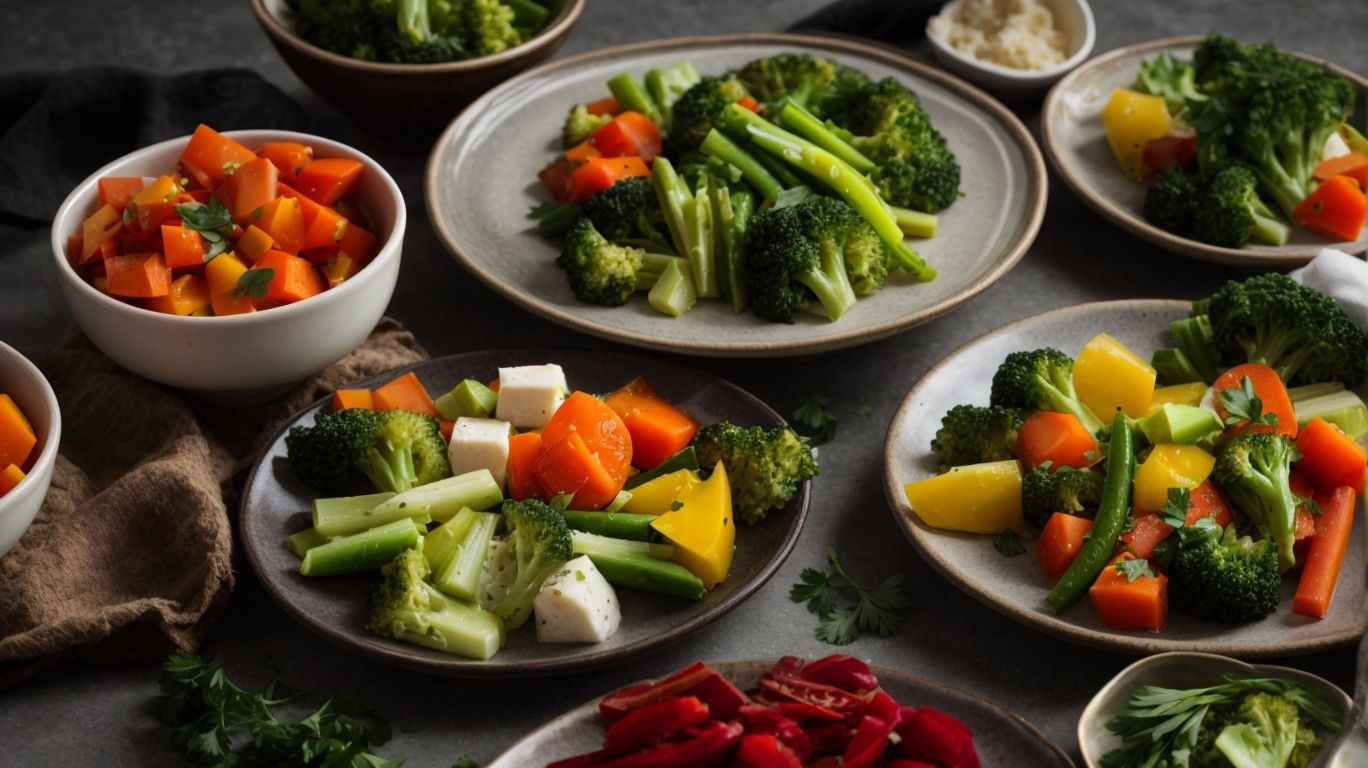
Credits: Poormet.Com – Stephen Jones
Steamed vegetables offer versatility in serving options, whether enjoyed as a simple side dish, incorporated into a vibrant salad, or featured in a flavorful stir-fry dish, catering to various culinary preferences.
When serving steamed vegetables as a side dish, a sprinkle of seasoning can elevate their natural flavors, be it a dash of sea salt, a drizzle of olive oil, or a squeeze of fresh lemon juice.
For a wholesome salad, mix steamed veggies like broccoli, carrots, and snow peas with leafy greens, cherry tomatoes, and a vinaigrette dressing for a refreshing and nutritious meal.
If aiming for a more substantial meal, consider tossing steamed vegetables into a sizzling stir-fry pan with your choice of protein and aromatic spices for a satisfying feast.
As a Side Dish
Steamed vegetables shine as a classic side dish option, offering a nutritious and visually appealing accompaniment to main courses, with endless seasoning and garnishing possibilities to elevate the dining experience.
One of the key advantages of incorporating steamed vegetables into your meal is their ability to retain their natural flavors and nutrients while delivering a satisfying crunch. To enhance their flavor profile, consider drizzling olive oil and a squeeze of fresh lemon juice, sprinkling herbs like thyme and rosemary, or adding a sprinkle of parmesan cheese. For a pop of color and added nutrition, you can top them with pomegranate seeds or toasted almonds, creating a delightful visual contrast.
In a Salad
Incorporating steamed vegetables into salads adds a delightful texture and flavor dimension, creating a wholesome and satisfying dish that caters to both health-conscious individuals and culinary enthusiasts.
Steaming vegetables helps to retain their natural color, nutrients, and crunch, enhancing the overall freshness of the salad. The gentle cooking process of steaming also ensures that the vegetables maintain their firmness without becoming soggy, resulting in a pleasant contrast to the salad greens. In terms of flavor, steamed vegetables offer a subtle sweetness that complements the other ingredients in the salad, making each bite a burst of deliciousness.
In a Stir-Fry
Steamed vegetables can be a versatile addition to stir-fry dishes, contributing vibrant colors, crisp textures, and nutrient-rich elements to the overall stir-fry experience, enhancing both taste and presentation.
When integrating steamed vegetables into a stir-fry, it’s crucial to consider the timing and cooking technique. By partially steaming the veggies beforehand, they retain their firmness and brightness, adding a delightful contrast to the softer stir-fry components. Pairing them with stir-fry techniques like high heat cooking and quick tossing allows the vegetables to maintain their individual flavors while absorbing the savory sauces, resulting in a well-balanced and flavorful dish. This combination not only elevates the visual appeal of the stir-fry but also ensures a satisfying texture and taste with each bite.
Conclusion: Experiment and Enjoy!
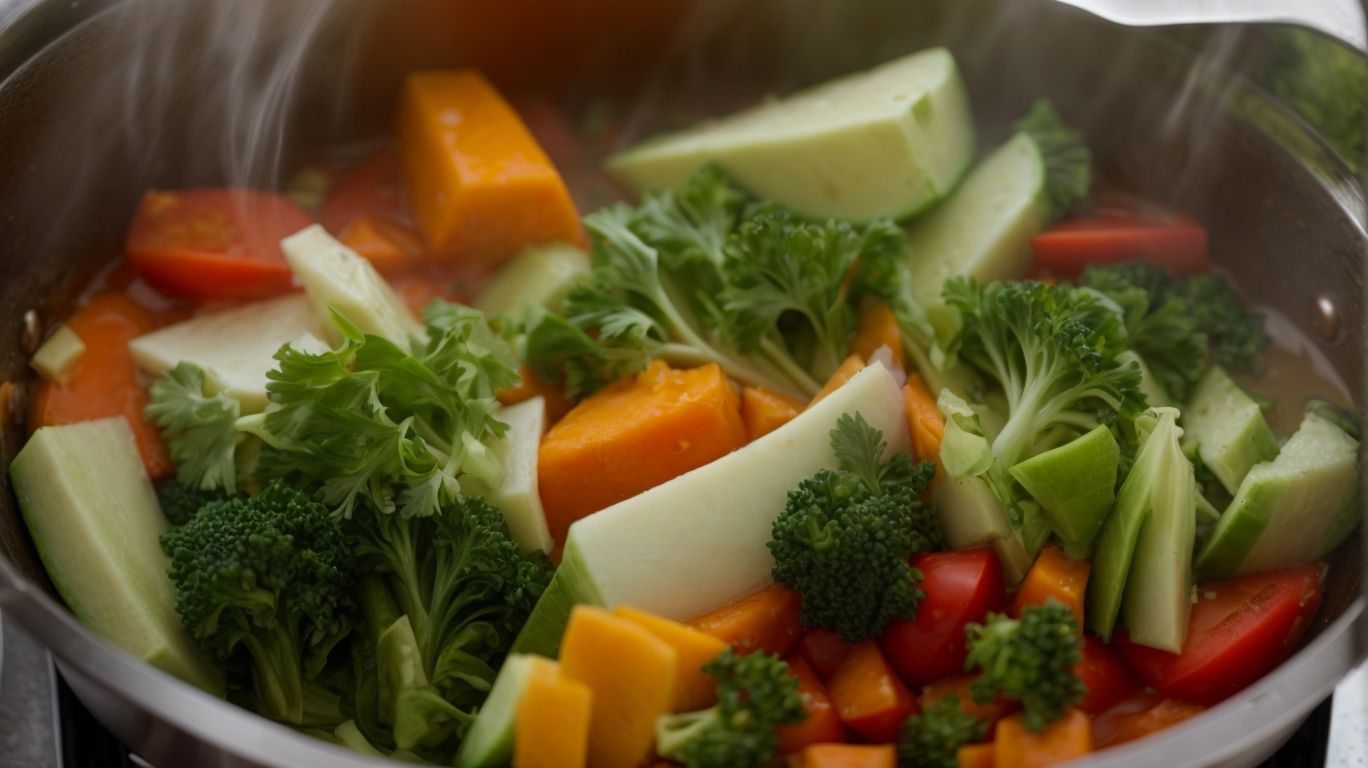
Credits: Poormet.Com – Nathan Roberts
Steaming vegetables opens up a world of culinary possibilities where experimentation meets enjoyment, allowing individuals to savor the natural goodness of vegetables through a simple yet rewarding cooking method.
By incorporating a variety of herbs, spices, and sauces into your steaming process, you can elevate the flavors of your vegetables in unique ways.
Experimentation is the key – try different combinations to discover your favorite flavors. Steaming retains more nutrients compared to other cooking methods, ensuring you reap the maximum health benefits from your veggies.
Whether you prefer a medley of colorful vegetables or keep it simple with a single vegetable, steaming offers versatility that caters to all tastes. So, unleash your creativity in the kitchen and enjoy the journey of discovering new, delicious ways to enjoy steamed vegetables!
Frequently Asked Questions
How to Cook Vegetables by Steam?
Cooking vegetables by steaming is not only a healthier option, but it also helps to retain their nutrients and flavors. Here are some frequently asked questions about this cooking method.
1. What vegetables are best suited for steaming?
Most vegetables can be cooked by steaming, but some options work better than others. Vegetables like broccoli, carrots, green beans, Brussels sprouts, and cauliflower are perfect for steaming as they don’t require a lot of time and retain their crunchiness.
2. Do I need any special equipment to steam vegetables?
No, you don’t need any special equipment to steam vegetables. All you need is a pot with a lid and a steamer basket. If you don’t have a steamer basket, you can use a colander or a mesh strainer that fits inside the pot.
3. How do I prepare vegetables for steaming?
Before steaming, wash the vegetables thoroughly and trim any excess stems or leaves. For vegetables like broccoli and cauliflower, cut them into florets. For carrots, slice them into even pieces, and for green beans, trim the ends.
4. How long does it take to steam vegetables?
The time required for steaming vegetables depends on the type and size of the vegetables. Generally, most vegetables take between 5-10 minutes to steam. You can test their doneness by piercing them with a fork. If it goes in easily, they are done.
5. Can I add seasoning or flavorings while steaming vegetables?
Yes, you can add seasoning or flavorings to your vegetables while steaming. This will infuse the vegetables with additional flavors. Some options include herbs, spices, lemon juice, or a drizzle of olive oil.
6. Can I steam frozen vegetables?
Yes, you can steam frozen vegetables, but it may take longer than fresh vegetables. Make sure to follow the instructions on the packaging for the recommended cooking time. You may also need to add a splash of water to the pot to create steam since frozen vegetables do not release as much moisture as fresh ones.

